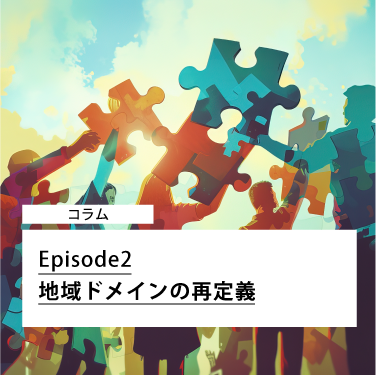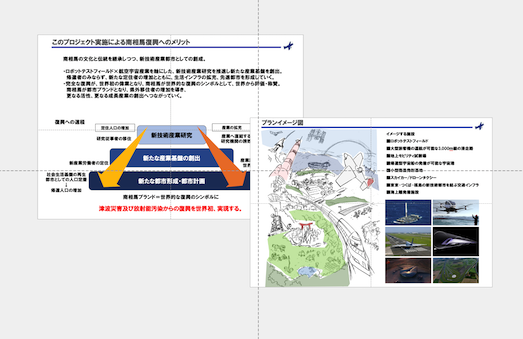2025.06.03
Episode2 Redefining regional domains

What is the redefinition of geographic domains?
Today’s episode is “Redefining the Regional Domain”.
In my work, I often take on the task of formulating strategies for “city promotion” and “city branding”.
The purpose of this work is to increase the resident population and attract tourists,
to find new value in the region by utilizing the strengths of the city or town in question, and not only to strengthen the intention of residents to settle there, but also to promote it to potential residents and tourists.
To attract science-related companies to a city with a strong industrial image, redefine it as a cutting-edge science and technology city,
to add renewable energy to a city with a nuclear power plant that is considered dangerous, and brand it as a sustainable society.
If there are 10 cities or towns, each one will be redefined differently.
The method of “redefining the regional domain” generally begins with rediscovering or excavating the regional resources.
Pick one or more resources from this region and create a new concept for the regional domain.
Once the concept is created, the next step is to carry out PR and branding, while at the same time attracting and carrying out activities to attract related companies and organizations.
Therefore, the process from “redefining the regional domain” to actually spreading awareness and seeing the effects of the measures is not something that can be done overnight.
Today, we will look at the example of “redefining the regional domain” in one city.
As mentioned above, it is generally important to look at the strengths of the region,
but in this region, it began in unusual circumstances.
Areas hit by tragedy
Eight years ago, I received a phone call from the president of one of our partner companies.
The request was for ideas for revitalizing the area hit by the Great East Japan Earthquake.
The area was M City.
The area was hit by a complex disaster of earthquake, tsunami, and the Fukushima Daiichi Nuclear Power Plant accident.
We immediately went to inspect the area.
The city arranged the inspection schedule and even showed us around by car.
Although six years had already passed since the disaster, the scars of the disaster remained everywhere.
Deteriorating houses with no inhabitants and places that had been demolished and turned into vacant lots.
Or, perhaps as a sign of the area’s efforts to make a comeback, there were also newly built houses here and there.
At the time, I felt that the area was a mixture of resignation and hope for the future.
Particularly impressive was the words of the city employee who showed us around.
“Due to the radioactive contamination, it will be difficult to reuse the land for agriculture, factories, or residential areas.”
Yes, of course, the disaster had caused many strengths to be lost throughout the region.
So, how do we design a strategy?
It’s a more difficult question than ever before.
Turning weaknesses into strengths
On the way back to the city, I was thinking about how to design a strategy.
Then, I suddenly remembered the words of the city official who had guided me.
“Due to the radioactive contamination, it may be difficult to reuse the land for agriculture, factories, or residential areas.”
How do we use the land that can no longer be used?
Then, I had an idea: a runway.
With a runway, there would be no crops or people living there, so the amount of radiation exposure would be minimal.
“It’s not that easy to build an airport, and is there really any demand for it in rural areas?”
You might have thought.
However, I thought that it was hopeless to utilize the land due to the radioactive contamination,
but if you change your perspective,
it was a moment when I realized that this weakness could be turned into a strength.
By the way, it’s not an airport.
It’s exactly a “space runway”!
A space base needs to be on the Pacific coast,
and it needs a large area of land.
Of course, a space base is not something that can be built easily.
However, this idea was useful in formulating an actual strategy.

And proposed to the city
From there, we worked with the aforementioned partner company to formulate a strategy.
The city already had a budget for earthquake reconstruction,
so they already had laboratories for robot and drone development.
By adding the “aviation and space industry” to that, we redefined the area as one with a new technology industry.
Divided into Phase 1 to Phase 3,
we started with developing small aircraft, establishing a new department for the “aviation and space industry” at a vocational school, and creating a system for industry and human resources to grow together, and finally the expansion of space-related industries.
We then put it together as a proposal to the city.
And on the day of the proposal.
Under a hazy sky, we entered the city hall conference room.
From the city were the deputy mayor and several staff members,
and we were four people, including staff from the aforementioned partner company.
We immediately started our proposal, and about 10 minutes into explaining the key parts of the proposal,
a strange thing happened.
I said,
“By incorporating the aerospace industry… we will turn this city of tragedy into a city of hope!”
And then, with a bang, lightning struck!?
There was a window behind me where I was sitting, and the staff were on the other side, so everyone seemed quite surprised (laughs).
I still remember them saying, “That’s an amazing production.”
There was only one lightning strike, either before or after, and it was a slightly cloudy day, so the weather wasn’t suitable for lightning.
Oops, I digressed.
Back to the main topic.
And now, eight years later
I will tell you what happened after that proposal.
The city started considering introducing the “aviation and space industry” and set up a preparation office.
We decided to leave the execution to a partner company and support their work by seconding our company.
First of all, we built a runway for test aircraft, provided technical advice to vocational schools,
developed new aircraft (we will utilize the details), etc., and the project is progressing slowly but surely.
So, how will the space station be done in Phase 3?
But let me keep this a company secret.
I will visit a space-related company in the US this summer.
I will definitely not give up on my goal of building a space station in Japan.
If there is anything I can disclose, I will report it in this column, so please look forward to it.
After a series of slightly larger-scale strategy cases,
next time I will introduce a fairly small and tear-jerking strategy case.
Written by Hiroshi Ashida
